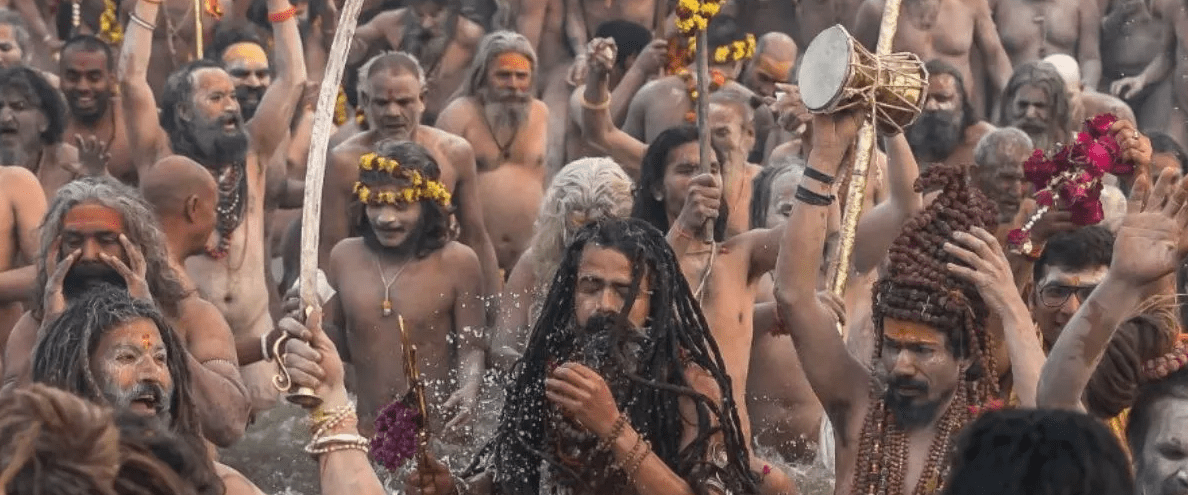Juna Akhada is one of the oldest, most influential, and largest Shaiva Akhadas (monastic orders) in India. It is a powerful spiritual organization of Naga Sadhus—renunciate warriors dedicated to Lord Shiva. With a legacy spanning centuries, Juna Akhada holds a prominent place in Hindu traditions, religious practices, and the Kumbh Mela, where its saints are among the first to take the Shahi Snan (royal bath).
This article explores the origins, history, Mahamandaleshwars, associated ashrams, rituals, and significance of Juna Akhada in the Hindu monastic tradition.
1. Origins and History of Juna Akhada
Establishment and Roots
Juna Akhada was founded in the 4th century CE by Adi Shankaracharya as part of his mission to establish monastic orders (Dashanami Sannyasa tradition) to protect Sanatana Dharma.
It is one of the Dashanami Akhadas, meaning it follows the ten monastic orders established by Adi Shankaracharya.
The Akhada’s headquarters is in Varanasi, Uttar Pradesh, the holiest city for Shaivites.
Role in Preserving Hinduism
In medieval India, Hinduism faced threats from invasions and conversions. The Naga Sadhus of Juna Akhada became warrior saints to protect temples, sacred places, and dharma.
These monks are known for their asceticism, celibacy, and extreme penance.
The Akhada also played a key role in reviving Vedic traditions, promoting Advaita Vedanta, and training monks in both spiritual wisdom and martial skills.
2. Organizational Structure of Juna Akhada
Juna Akhada follows a hierarchical system:
A. Mahamandaleshwar (Supreme Spiritual Leaders)
The title Mahamandaleshwar is given to the highest spiritual heads of Juna Akhada.
They oversee spiritual activities, rituals, the selection of sadhus, and temple administration.
The current Acharya Mahamandaleshwar is Swami Avdheshanand Giri, a globally recognized spiritual leader.
B. List of Notable Mahamandaleshwars of Juna Akhada
Some of the prominent Mahamandaleshwars of Juna Akhada include:
Swami Avdheshanand Giri (Current Acharya Mahamandaleshwar)
Swami Hari Giri
Swami Vishwadevanand Giri
Swami Pragyananand Giri
Swami Anand Giri
Swami Vasudevanand Saraswati
These leaders play a crucial role in guiding the Naga Sadhus and overseeing the Akhada’s religious affairs.
C. Naga Sadhus – The Warrior Monks
Juna Akhada is home to thousands of Naga Sadhus, the most disciplined and powerful renunciates in Hinduism.
They live naked or in minimal clothing, symbolizing their complete detachment from worldly life.
Many of them practice extreme austerities like meditation in snow-clad mountains and walking barefoot across India.
3. Prominent Ashrams Associated with Juna Akhada
A. Parmarth Niketan Ashram, Haridwar
📍 Location: Haridwar, Uttarakhand
One of the most famous spiritual centers in India.
Known for the daily Ganga Aarti and yoga programs.
Hosts spiritual discourses, meditation retreats, and social service programs.
B. Acharya Mahamandaleshwar Ashram, Haridwar
📍 Location: Haridwar, Uttarakhand
A major center for Naga Sadhus and disciples of Juna Akhada.
Acts as a training ground for Shaiva sadhana, Vedantic studies, and ascetic practices.
Plays an important role during Kumbh Melas, serving as a spiritual hub for thousands of sadhus.
4. Rituals and Traditions of Juna Akhada
Juna Akhada follows a strict spiritual regimen based on Shaivism, Vedic rituals, and ascetic traditions. Some of the key practices include:
A. Initiation into Naga Sannyasa
Entry into Juna Akhada is not easy—aspirants must renounce worldly attachments and undergo rigorous training for years.
The Diksha (initiation) is given by senior Mahamandaleshwars, following ancient Shaiva rituals.
Sacred vows include celibacy, renunciation of possessions, and complete devotion to Lord Shiva.
B. Kumbh Mela and Shahi Snan
Juna Akhada leads the Shahi Snan (royal bath) at Kumbh Mela, where thousands of Naga Sadhus march naked into the Ganga.
It is a moment of spiritual purification, where devotees believe the water of the Ganga turns into Amrit (nectar of immortality).
Juna Akhada's processions during Kumbh Mela are grand, vibrant, and symbolically powerful.
C. Daily Rituals
Shiva Puja: Dedicated prayers and offerings to Lord Shiva.
Havan & Yajna: Vedic fire ceremonies for purification and blessings.
Meditation & Yoga: Practiced by all monks for self-realization and mental discipline.
D. Shivaratri Celebrations
One of the most important festivals for Juna Akhada.
Naga Sadhus observe intense fasting, meditation, and night-long worship of Lord Shiva.
The grandest celebrations happen in Varanasi, Ujjain, and Haridwar.
5. Influence and Impact of Juna Akhada
A. Spiritual Leadership
Juna Akhada is a guiding force for millions of devotees, providing spiritual guidance, promoting Sanatana Dharma, and spreading the teachings of Advaita Vedanta.
B. Protection of Hindu Traditions
Historically, Naga Sadhus of Juna Akhada have defended temples and dharma against foreign invasions.
C. Social and Humanitarian Activities
Juna Akhada is involved in charitable works, medical camps, education, and disaster relief programs.
The Parmarth Niketan Ashram leads various environmental and social service initiatives.
6. How to Visit Juna Akhada and Its Ashrams?
Best Time to Visit
Kumbh Mela (held every 12 years) – The best time to witness Juna Akhada in full spiritual grandeur.
Maha Shivaratri – Ideal for experiencing deep Shaivite rituals and celebrations.
Chaturmas (monsoon retreat) – A period when monks stay in one place, teaching spirituality.
How to Reach?
Haridwar & Varanasi have well-connected rail, road, and air networks.
Visitors can stay at Parmarth Niketan or other ashrams to experience the spiritual life.
Juna Akhada is not just a religious order—it is a living embodiment of Sanatana Dharma, keeping alive the unbroken lineage of Shaivism, Advaita Vedanta, and warrior monks. Whether through spiritual leadership, ascetic practices, or grand processions at Kumbh Mela, Juna Akhada continues to inspire millions of seekers on the path of divine wisdom.
🚩 Have you visited Juna Akhada or seen the Naga Sadhus at Kumbh Mela? Share your experience in the comments! 🚩



